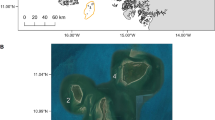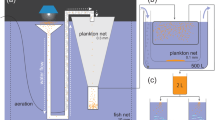Abstract
Both food abundance and predation risk may influence habitat use decisions. However, studies of habitat use by birds in marine environments have focused only on food abundance. I investigated the possible influences of food abundance and predation risk from tiger sharks (Galeocerdo cuvier) on habitat use by pied cormorants (Phalacrocorax varius) over two spatial scales and on cormorant group size. Cormorants were usually solitary, but group size was highest in shallow habitats during months when shark density was low. Regardless of season, cormorant density within shallow habitats was higher over seagrass than sand, and cormorants were distributed between these two microhabitats proportional to prey density. Therefore, cormorants appear to respond to prey abundance at a relatively narrow spatial scale (i.e., tens of meters). At the habitat-patch scale (~1 km), the density of cormorants and their prey (teleosts) was higher in shallow habitats than in deep ones, but the density of cormorants was influenced by an interaction between water temperature (i.e., season) and habitat. There was decreased use of shallow habitats as water temperature, and the density of tiger sharks, increased. When shark density was low, cormorants were distributed across habitats roughly in proportion to the abundance of fish, suggesting that cormorants respond to food abundance at the scale of habitat patches. However, as shark abundance increased, the relative density of cormorants dropped in the dangerous shallow habitats such that there was a greater density of cormorants relative to their food in deep habitats when sharks were abundant. This suggests that pied cormorants trade-off food and risk by accepting lower energetic returns to forage in safer habitats. This study provides the first evidence that marine habitat selection by birds may be influenced by such a trade-off, and provides further evidence that tiger sharks are important in determining habitat use of their prey and mediating indirect interactions within Shark Bay.






Similar content being viewed by others
References
Abrahams MV, Dill LM (1989) A determination of the energetic equivalence of the risk of predation. Ecology 70:999–1007
Baalen M van, Sabelis MW (1993) Coevolution of patch selection strategies of predator and prey and the consequences for ecological stability. Am Nat 142:646–670
Bertram BCR (1978) Living in groups: predators and prey. In Krebs JR, Davies NB (eds). Behavioural ecology: an evolutionary approach, 4th edn. Blackwell, Oxford, pp 64–96
Brown JS, Laundré JW, Gurung (1999) The ecology of fear: optimal foraging, game theory and trophic interactions. J Mamm 80: 385–399
Cairns DK, Schneider DC (1990) Hot spots in cold water: feeding habitat selection by thick-billed murres. Stud Avian Biol 14:52–60
Cresswell W (1994) Age-dependent choice of redshank (Tringa totanus) feeding location: profitability or risk? J Anim Ecol 63:589–600
Dill LM, Heithaus MR, Walters CJ (2003) Behaviorally mediated indirect species interactions (BMII) in marine communities: importance in community dynamics and conservation. Ecology 84:1151–1157
Dorfman E J, Kingsford MJ (2001) Environmental determinants of distribution and foraging behaviour of cormorants (Phalacrocorax spp.) in temperate estuarine habitats. Mar Biol 138:1-10
Fauchald PK, Erikstad E, Skarsfjord H (2000) Scale-dependent predator-prey interactions: the hierarchical spatial distribution of seabirds and prey. Ecology 81:773–783
Fretwell SD, Lucas HL (1970) On territorial behavior and other factors influencing habitat distribution in birds. Acta Biotheor 19: 16–36
Frid A, Dill LM (2002) Human-caused disturbance stimuli as a form of predation risk. Conservation Ecology 6: http://www.consecol.org/Journal/vol6/iss1/art11/print.pdf
Gilliam JF, Fraser DF (1987) Habitat selection under predation hazard: test of a model with foraging minnows. Ecology 68:1856–1862
Heithaus MR (2001a) Habitat use decisions by bottlenose dolphins (Tursiops aduncus) and tiger sharks (Galeocerdo cuvier) in a subtropical seagrass ecosystem. PhD dissertation, Simon Fraser University: Burnaby, British Columbia
Heithaus MR (2001b) The biology of tiger sharks (Galeocerdo cuvier) in Shark Bay, Western Australia: sex ratio, size distribution, diet, and seasonal changes in catch rates. Environ Biol Fish 61:25–36
Heithaus MR (2001c) Shark attacks on bottlenose dolphins (Tursiops aduncus) in Shark Bay, Western Australia: attack rate, bite scar frequencies, and attack seasonality. Mar Mamm Sci 17:526–539
Heithaus MR (2004) Fish communities of seagrass meadows and associated habitats in Shark Bay, Western Australia. Bull Mar Sci 75:79–99
Heithaus MR, Dill LM (2002a). Feeding strategies and tactics. In: Perrin WF, Würsig B, Thewissen HGM (eds) The encyclopedia of marine mammals. Academic Press, New York, pp 412–422
Heithaus MR, Dill LM (2002b). Food availability and predation risk influence bottlenose dolphin habitat use. Ecology 83:480–491
Heithaus MR, Dill LM, Marshall GJ, Buhleier, BM (2002) Habitat use and foraging behavior of tiger sharks (Galeocerdo cuvier) in a seagrass ecosystem. Mar Biol 140:237–248
Lessels CM (1995) Putting resource dynamics into continuous input ideal free distribution models. Anim Behav 49:487–494
Lima SL (1998) Stress and decision making under the risk of predation: recent developments from behavioral, reproductive, and ecological perspectives. Adv Stud Behav 27:215–290
Lima SL, Dill LM (1990) Behavioral decisions made under the risk of predation: a review and prospectus. Can J Zool 68:619–640
Lowe CG, Wetherbee BM, Crow GL, Tester AL (1996) Ontogenetic dietary shifts and feeding behavior of the tiger shark, Galeocerdo cuvier, in Hawaiian waters. Environ Biol Fish 47:203–211
Montevecchi WA, Meyers RA (1995) Prey harvests of seabirds reflect pelagic fish and squid abundance at multiple spatial and temporal scales. Mar Ecol Prog Ser 117:1-9
Peacor SD, Werner EE (2000) Predator effects on an assemblage of consumers through induced changes in consumer foraging behavior. Ecology 81:1998–2010
Peacor SD, Werner EE (2001) The contribution of trait-mediated indirect effects to the net effects of a predator. Proc Natl Acad Sci USA 98:3904–3908
Piatt JF (1990) The aggregative response of common murres and Atlantic puffins to schools of capelin. Stud Avian Biol 14:36–51
Russell RW, Hunt GL, Coyle KO, Cooney RT (1992) Foraging in a fractal environment: spatial patterns in a marine predator-prey system. Landsc Ecol 7:195–209
Schmitz OJ, Beckerman AP, O’Brien KM (1997) Behaviorally mediated trophic cascades: effects of predation risk on food web interactions. Ecology 78:1388–1399
Sheaves MJ (1992) Patterns of distribution and abundance of fishes in contrasting habitats in a mangrove-lined tropical estuary as determined by fish traps. Aust J Mar Freshw Res 43:1461–1479
Sheaves MJ (1995) Effect of design modifications and soak time variations on Antillean-Z fish trap performance in a tropical estuary. Bull Mar Sci 56:475–489
Simpfendorfer CA (1992) Biology of tiger sharks (Galeocerdo cuvier) caught by the Queensland shark meshing program off Townsville, Australia. Aust J Mar Freshw Res 43:33–43
Simpfendorfer CA, Goodreid AB, McAuley RB (2001) Size, sex, and geographic variation in the diet of the tiger shark (Galeocerdo cuvier) in Western Australian waters. Environ Biol Fish 61:37–46
SPSS (1998) Systat 8.0 for Windows. SPSS, Chicago, Ill.
Wilkinson L, Blank G, Gruber C (1996) Desktop data analysis with Systat. Prentice Hall, Englewood Cliffs, N.J.
Zar JH (1984) Biostatistical Analysis. Prentice Hall, Englewood Cliffs, N.J.
Acknowledgments
I thank the National Geographic Society Expeditions Council, NSERC Canada (grant A6869 to L.M. Dill) and the Monkey Mia dolphin resort for providing financial and logistical support for fieldwork. Simon Fraser University, the National Science Foundation, and Florida International University provided personal support. J. McLash, L. Barre, J. Burghardt, C. Genrich, S. Buchannan, F. Bretos, P. Greene, and H. Finn provided field assistance. A. Frid helped with statistical analyses. Finally, I thank A. Frid, D. Moore, E.R. Heithaus and L.M. Dill for comments. Transects were conducted under authority of Western Australia Department of Conservation and Land Management permits DI000044, NE001649, DI 000067, and NE001927. This is contribution 16 of the Shark Bay Ecosystem Research Project.
Author information
Authors and Affiliations
Corresponding author
Additional information
Communicated by P. W. Sammarco, Chauvin
Rights and permissions
About this article
Cite this article
Heithaus, M.R. Habitat use and group size of pied cormorants (Phalacrocorax varius) in a seagrass ecosystem: possible effects of food abundance and predation risk. Marine Biology 147, 27–35 (2005). https://doi.org/10.1007/s00227-004-1534-0
Received:
Accepted:
Published:
Issue Date:
DOI: https://doi.org/10.1007/s00227-004-1534-0




